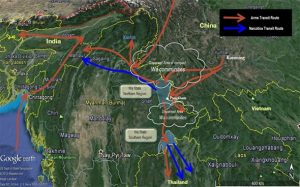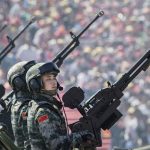Introduction
The concept of security has broadened over the years. Along with the traditional threats to the territorial integrity and sovereignty of a state, it also envisages the non-traditional threats in the form of climate change, organised crime, illegal migration, arms & drug trafficking etc. Amongst these, the illicit proliferation and misuse of small arms is a major security threat to India. According to the National Crime Records Bureau, in the year 2018, a total of 74,877 firearms were seized, out of which 3,742 arms were licensed/factory made, while 71,135 arms were unlicensed/improvised/crude/country made.[1] The incessant demand for weapons in India proliferated over the years due to the low-intensity conflicts in Northeast India, Left-Wing extremism affected areas and Jammu and Kashmir. An unhindered inflow of small arms from different routes eventually reaches the insurgents, maoists, terrorists and other criminals. Illicit manufacture of local country made guns, stealing from government stocks, inadequate monitoring and surveillance etc, has further aggravated the situation. The Indian subcontinent is particularly vulnerable to this menace of contraband arms smuggling. Many reasons can be attributed to this vulnerability. Afghanistan-Pakistan region in the subcontinent arguably contains the world’s largest concentration of illicit weapons. Also, the region is host to two of the largest opium producing corridors, namely the ‘Golden Triangle’ and the ‘Golden Crescent’. The most prominent example of smuggling of contraband arms and weapons in India is from Yunnan province in China to the insurgent groups of Northeast India via Myanmar.
Arms Smuggling and Northeast India
Since the outbreak of insurgency in 1950s, Northeast India has been encountering the challenge of rampant proliferation of firearms and weapons. Arming and training the Northeast insurgents to fight against the Indian State started in the 1950s with Pakistani Army supporting the Naga rebels with weapons such as self-loading rifles, light machine guns and mortars. It has been noted that the bulk of this smuggling occurs from the Yunnan province of China via Myanmar and Bangladesh into the region. Intelligence inputs even suggest the existence of historical linkages between the Northeast insurgents and China and claims that the armoury acquired from China is smuggled through Thailand, Bangladesh and Sino-Myanmar borders into the Northeastern states.[2] India shares over 1600 km and 4000 km long border with Myanmar and Bangladesh respectively. Northeastern states including Assam, Manipur, Meghalaya, Mizoram, Nagaland and Tripura are situated along either of these borders. These borders are prone to security breaches due to several reasons including inadequate fencing, regular migration of people, the rough terrain of the border areas etc.
Map 1: Arms Smuggling Networks along Northeast India

Source: Namrata Goswami, ‘Tracking the source of Weapon Providers for NE Rebels’, IDSA, 7 November 2013, available at https://idsa.in/idsacomments/TrackingthesourceofWeaponProvidersforNERebels_ngoswami_071113
This smuggling is facilitated by insurgents groups of Myanmar such as the Karen National Union (KNU), Kachin Independence Army (KIA) and the United Wa State Army (UWSA) and Pakistan’s ISI also facilitates the shipping of contraband arms through the Bay of Bengal. Firearms, assault rifles and grenades are readily available at hubs across Assam, Manipur, Nagaland, Arunachal Pradesh and Meghalaya and a good majority of all arms consignments originate in China.[3] Marks found on the surrendered weapons by insurgent outfits in 2019, especially the United Liberation Front of Assam (ULFA), indicates that UWSA continues to be the major supplier of contraband arms to the Northeast insurgent groups. Rajeev Bhattacharya in his research paper mentions that “earlier, the shipments originated in Thailand which received the arms from China and Cambodia. These were shipped to Cox Bazar and Chittagong and from there to Northeast India. Sonamura in Tripura, Jayantia and Garo Hills in Meghalaya and Dhubri in Assam were the favoured entry points for supply to NSCN-IM, ULFA, Bodo and Manipuri rebels until Operation Golden Bird (1995), a joint India-Myanmar military operation against the arms smugglers”.[4] Henceforth, deals are struck in Ruili and Tengchong in Yunnan province of China. These are sent to different spots along the Indo-Myanmar border. Phek in Nagaland, Chandel and Churachanpur in Manipur and Champai in Mizoram are the entry points to other destinations.[5] Due to the geographical proximity of Northeast India to the ‘Golden Triangle’, a symbiotic relationship between narcotics traffickers and arms smugglers has been established in the region. Most commonly, insurgent groups either produce drugs to smuggle or tax/extort money from drug traffickers in return for protected passage for their illicit trade. In turn, this money is used for the purchase of sophisticated arms and weapons by the insurgents from abroad. With the technological advancement of weapons, these are easy to obtain, conceal and smuggle across borders. Many Northeast insurgent groups such as the NSCN-IM, NSCN-Khaplang, United National Liberation Front, Kanglei Yawol Kanna Lup, Zomi Revolutionary Organisation and Kuku National Army are involved in taxing the drugs and arms shipments transiting through their areas.
The arms smugglers are well aware of the difficult geographical terrain of the region. Also, they easily mix with the locals who unknowingly assist the smugglers in achieving their aim. However, the security officials posted along the border face the challenges posed by dense forests, hilly terrain and densely populated habitats of this area, limiting their surveillance capacity. In 2019, it was reported that the UWSA continued to supply arms and weapons to the insurgent outfits of Northeast India[6]. It is interesting to note that the biggest source of revenue for this group is their illegal arms network across South and Southeast Asia. It has been established by security agencies that there exists a close linkage between the group and Chinese ordnance factory- Norinco. There exists an ‘informal franchise’ between the two which allows them to manufacture and procure Chinese weapons. The arms manufacturing unit in the Wa State of Myanmar, supported by the Chinese ordnance factories in Yunnan manufacture machine guns, pistols, rifles and revolvers.[7]
Amongst the Northeastern states, Mizoram has emerged as South Asia’s biggest smuggling hub for ecstasy drugs, gold and guns[8]. Many of the Chin refugees, illegally settled in Mizoram have been caught for their involvement in various international arms smuggling networks, in close linkage with the UWSA. In May 2018, the Directorate of Revenue Intelligence (DRI) in a joint operation with the Assam Rifles busted a major racket involving firearm smuggling from Myanmar into India through the Mizoram border for further delivery to some insurgent groups in Bangladesh[9]. Also, West Bengal, bordering Bangladesh stood fourth in the country for unlicensed firearms seizures in 2017 according to the NCRB. Many central security agencies have warned of the alarming situation wherein these weapons are shipped from the state to the Northeast through Bangladesh[10]. Arms smuggling through Bangladesh is further facilitated by the dense forests of Chittagong hill tracts providing the smugglers safe haven and allowing them to sneak the weapons into India through the porous borders. The coastal border points between Bangladesh and Myanmar are also regarded as points for transit of contraband arms. These shipments land on coasts of South Bangladesh and Northwest Myanmar and then smuggled in smaller consignments into Northeast India.
Suggested Control Measures
To curb this threat, it is essential that robust measures are employed at the national, regional and international levels. At the national level, India needs to undertake a multipronged approach. Considering the porosity of India- Myanmar and India-Bangladesh borders, border management in these areas need to be further strengthened. This can be achieved through the use of technology in the form of Unmanned Aerial Vehicles (UAVs) in areas where physical presence or fencing is not feasible. Moreover, non-invasive inspection techniques such as explosive vapour detectors, full-body scanners, metal detectors and handheld substance detectors can be used for the detection of concealed weapons, drugs, illicit radiological material, etc.[11] Such steps must be accompanied by a comprehensive Border Area Development Programme (BADP). At the regional level, the issue must be discussed at platforms such as the Association of Southeast Asian Nations (ASEAN) and the Bay of Bengal Initiative for Multi-Sectoral Technical and Economic Cooperation (BIMSTEC). At the international level, the United Nations after prolonged discussions finalised an Arms Trade Treaty in 2014. Though the treaty strives to regulate the international trade in conventional arms ranging from small arms to battle tanks, combat aircraft and warships. However, India is not a signatory to the treaty and has raised certain objections in terms of the inability of the treaty to make some real impact on the illicit trafficking carried out by terrorists and other unauthorised and unlawful non-state actors. Hence, the international community must assess the shortcomings of the treaty and make it more robust.
Conclusion
Smuggling of contraband arms poses a serious challenge to India’s national security. Northeast India has witnessed prolonged violence since 1950s. At a time when there has been a steep decline in the insurgency related incidents in the region, if unchecked, arms smuggling will again push the region into chaos. Hence, it is important that the problem be given adequate attention and eliminated through holistic national security policies.
References:
[1] National Crime Records Bureau, ‘Crime in India 2018, Volume I. Available at http://ncrb.gov.in/crime-india-2018
[2] Press Information Bureau, ‘Inputs Suggest Visit to China by Leaders of NE Insurgent Groups, 9 March 2011. Available at https://pib.gov.in/newsite/PrintRelease.aspx?relid=70786
[3] Rajiv Bhattacharya, “Small Arms Proliferation in the Northeast: The Chinese Connection”, AAKROSH, Vol No. 13, Issue No. 49 (2010). Available at https://www.academia.edu/9310657/Small_Arms_Proliferation_in_Indias_Northeast_The_Chinese_Connection
[4] Ibid.
[5] Telegraph (Northeast Edition). “Arms Flow Feed Militancy.” 29 October 2004.
[6] NE NOW NEWS, “UWSA continues to supply arms to Northeast insurgents”, 30 May 2019. Available at https://nenow.in/north-east-news/uwsa-continues-to-supply-arms-to-northeast-insurgents.html
[7] Namrata Goswami, ‘Tracking the source of Weapon Providers for NE Rebels’, IDSA, 7 November 2013, available at https://idsa.in/idsacomments/TrackingthesourceofWeaponProvidersforNERebels_ngoswami_071113
[8] Anirban Roy, “Mizoram is biggest hub of drugs, gold and arms smuggling in South Asia”, 22 July 2019. Available at https://nenow.in/north-east-news/mizoram-is-biggest-hub-of-drugs-gold-and-arms-smuggling-in-south-asia.html
[9] Saurabh Vaktania, “DRI unearths major racket involving smuggling of firearms in North east”, 30 May 2018. Available at https://www.indiatoday.in/india/story/dri-unearths-major-racket-involving-smuggling-of-firearms-in-north-east-1245981-2018-05-30
[10] Tanmay Chatterjee, “Bengal 4th in illegal firearm seizure, oppn says state suppressing figures”, 5 November 2019. Available at https://www.hindustantimes.com/india-news/bengal-4th-in-illegal-firearm-seizure-oppn-says-state-suppressing-figures/story-I1nsD19aaqqngtixCQkviP.html
[11] FICCI, “Smart border management: An Indian Perspective”, September 2016. Available at https://www.pwc.in/publications/2016/smart-border-management-an-indian-perspective.html













